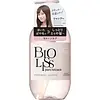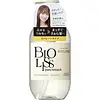What's inside
What's inside
 Key Ingredients
Key Ingredients

 Benefits
Benefits

 Concerns
Concerns

 Ingredients Side-by-side
Ingredients Side-by-side

Water
Skin ConditioningSodium Methyl Cocoyl Taurate
CleansingCocamidopropyl Betaine
CleansingLauryl Betaine
CleansingCitric Acid
BufferingGlycerin
HumectantArgania Spinosa Kernel Oil
EmollientAloe Barbadensis Leaf Extract
EmollientCarthamus Tinctorius Seed Oil
MaskingBetula Alba Bark Extract
MaskingSpiraea Ulmaria Flower Extract
Skin ConditioningTocopherol
AntioxidantPrunus Persica Fruit Extract
AbrasiveButylene Glycol
HumectantDisodium EDTA
PPG-2 Cocamide
PEG-50 Hydrogenated Castor Oil Isostearate
EmulsifyingAlcohol
AntimicrobialEthyl Olivate
EmollientTea-Cocoyl Glutamate
CleansingPEG-75 Dilaurate
EmulsifyingPolyquaternium-10
Polyquaternium-7
PEG-2 Laurate
EmulsifyingSodium Lauroyl Methylalanine
Water, Sodium Methyl Cocoyl Taurate, Cocamidopropyl Betaine, Lauryl Betaine, Citric Acid, Glycerin, Argania Spinosa Kernel Oil, Aloe Barbadensis Leaf Extract, Carthamus Tinctorius Seed Oil, Betula Alba Bark Extract, Spiraea Ulmaria Flower Extract, Tocopherol, Prunus Persica Fruit Extract, Butylene Glycol, Disodium EDTA, PPG-2 Cocamide, PEG-50 Hydrogenated Castor Oil Isostearate, Alcohol, Ethyl Olivate, Tea-Cocoyl Glutamate, PEG-75 Dilaurate, Polyquaternium-10, Polyquaternium-7, PEG-2 Laurate, Sodium Lauroyl Methylalanine
Water
Skin ConditioningCocamidopropyl Betaine
CleansingTea-Cocoyl Glutamate
CleansingSodium Methyl Cocoyl Taurate
CleansingSodium Lauroyl Methylalanine
PPG-2 Cocamide
Alcohol Denat.
AntimicrobialGlycerin
HumectantCarthamus Tinctorius Seed Oil
MaskingBetula Alba Bark Extract
MaskingSpiraea Ulmaria Flower Extract
Skin ConditioningTocopherol
AntioxidantPrunus Persica Fruit Extract
AbrasiveTagetes Lemmonii Leaf/Stem Extract
AntioxidantButylene Glycol
HumectantDisodium EDTA
PEG-50 Hydrogenated Castor Oil Isostearate
EmulsifyingEthyl Olivate
EmollientCitric Acid
BufferingPEG-75 Dilaurate
EmulsifyingSodium Lauroyl Glutamate
Polyquaternium-10
Phenoxyethanol
PreservativeMethylparaben
PreservativeEthyl Oleate
EmollientWater, Cocamidopropyl Betaine, Tea-Cocoyl Glutamate, Sodium Methyl Cocoyl Taurate, Sodium Lauroyl Methylalanine, PPG-2 Cocamide, Alcohol Denat., Glycerin, Carthamus Tinctorius Seed Oil, Betula Alba Bark Extract, Spiraea Ulmaria Flower Extract, Tocopherol, Prunus Persica Fruit Extract, Tagetes Lemmonii Leaf/Stem Extract, Butylene Glycol, Disodium EDTA, PEG-50 Hydrogenated Castor Oil Isostearate, Ethyl Olivate, Citric Acid, PEG-75 Dilaurate, Sodium Lauroyl Glutamate, Polyquaternium-10, Phenoxyethanol, Methylparaben, Ethyl Oleate
 Reviews
Reviews

Ingredients Explained
These ingredients are found in both products.
Ingredients higher up in an ingredient list are typically present in a larger amount.
Betula Alba Bark Extract is from the birch tree named Betula Alba.
Extract from Betula Alba tree can help sooth and protect the skin. Betula Alba contains tannins and triterpenes. Tannins have antioxidant and astringent properties. Triterpenes have been shown to help heal wounds.
Betula Alba Bark Extract may also be used to add scent to a product or to cover an unpleasant scent.
Learn more about Betula Alba Bark ExtractButylene Glycol (or BG) is used within cosmetic products for a few different reasons:
Overall, Butylene Glycol is a safe and well-rounded ingredient that works well with other ingredients.
Though this ingredient works well with most skin types, some people with sensitive skin may experience a reaction such as allergic rashes, closed comedones, or itchiness.
Learn more about Butylene GlycolCarthamus tinctorius seed oil comes from safflower, one of humanity's oldest crops.
Safflower seed oil contains a high percentage of linoleic acid and oleic acid. It also contains Vitamin E. These three components are effective moisturizers.
Vitamin E helps nourish your skin's lipid barrier. It is also a potent antioxidant. Antioxidants help fight free-radical molecules, or unstable molecules that may damage your skin cells.
Due to its high fatty acid content, this ingredient may not be malassezia folliculitis safe.
Thoughout history, safflower has been used for dying fabrics and in food as a saffron substitute.
Learn more about Carthamus Tinctorius Seed OilCitric Acid is an alpha hydroxy acid (AHA) naturally found in citrus fruits like oranges, lemons, and limes.
Like other AHAs, citric acid can exfoliate skin by breaking down the bonds that hold dead skin cells together. This helps reveal smoother and brighter skin underneath.
However, this exfoliating effect only happens at high concentrations (20%) which can be hard to find in cosmetic products.
Due to this, citric acid is usually included in small amounts as a pH adjuster. This helps keep products slightly more acidic and compatible with skin's natural pH.
In skincare formulas, citric acid can:
While it can provide some skin benefits, research shows lactic acid and glycolic acid are generally more effective and less irritating exfoliants.
Most citric acid used in skincare today is made by fermenting sugars (usually from molasses). This synthetic version is identical to the natural citrus form but easier to stabilize and use in formulations.
Read more about some other popular AHA's here:
Learn more about Citric AcidCocamidopropyl Betaine is a fatty acid created by mixing similar compounds in coconut oil and dimethylaminopropylamine, a compound with two amino groups.
This ingredient is a surfactant and cleanser. It helps gather the dirt, pollutants, and other impurities in your skin to be washed away. It also helps thicken a product and make the texture more creamy.
Being created from coconut oil means Cocamidopropyl Betaine is hydrating for the skin.
While Cocamidopropyl Betaine was believed to be an allergen, a study from 2012 disproved this. It found two compounds in unpure Cocamidopropyl Betaine to be the irritants: aminoamide and 3-dimethylaminopropylamine. High-grade and pure Cocamidopropyl Betaine did not induce allergic reactions during this study.
Learn more about Cocamidopropyl BetaineDisodium EDTA plays a role in making products more stable by aiding other preservatives.
It is a chelating agent, meaning it neutralizes metal ions that may be found in a product.
Disodium EDTA is a salt of edetic acid and is found to be safe in cosmetic ingredients.
Learn more about Disodium EDTAEthyl Olivate isn't fungal acne safe.
Glycerin is already naturally found in your skin. It helps moisturize and protect your skin.
A study from 2016 found glycerin to be more effective as a humectant than AHAs and hyaluronic acid.
As a humectant, it helps the skin stay hydrated by pulling moisture to your skin. The low molecular weight of glycerin allows it to pull moisture into the deeper layers of your skin.
Hydrated skin improves your skin barrier; Your skin barrier helps protect against irritants and bacteria.
Glycerin has also been found to have antimicrobial and antiviral properties. Due to these properties, glycerin is often used in wound and burn treatments.
In cosmetics, glycerin is usually derived from plants such as soybean or palm. However, it can also be sourced from animals, such as tallow or animal fat.
This ingredient is organic, colorless, odorless, and non-toxic.
Glycerin is the name for this ingredient in American English. British English uses Glycerol/Glycerine.
Learn more about GlycerinPEG-50 Hydrogenated Castor Oil Isostearate is a surfactant and emulsifier. It is used to keep ingredients together.
Due to its castor oil base, this ingredient may not be fungal-acne safe.
PEG-75 Dilaurate isn't fungal acne safe.
Polyquaternium-10 is an ammonium salt of hydroxyethylcellulose. It is a white and granular powder used as a film-former and anti-static agent.
This ingredient is commonly found in hair conditioning products. According to a manufacturer, its positive charge makes it great for absorbing hair proteins. The manufacturer also states this ingredient helps with curl retention.
For haircare friends: this ingredient is not a silicone.
Learn more about Polyquaternium-10We don't have a description for PPG-2 Cocamide yet.
Prunus Persica Fruit Extract comes from peaches.
Peaches are rich in antioxidants, such as Vitamins C, E and A. Antioxidants help reduce the signs of aging. These vitamins also have plenty of skin benefits on their own (for instance, Vitamin C, E helps with skin brightening).
Peach extract is also an abrasive. Abrasives are an agent used to wear away the surface of skin. They are used to help polish or exfoliate skin.
Emerging research shows Peach extract may help protect UV-B induced skin damage. However, further research is needed.
Learn more about Prunus Persica Fruit ExtractThis gentle cleansing and foaming ingredient is known for leaving a smooth feeling in skin and hair. It is made using coconut oil.
According to the manufacturer, it is soluble in water and has resistance to hard water, acid, and alkali.
Due to its coconut base, it may not be Malassezia folliculitis safe.
Learn more about Sodium Methyl Cocoyl TaurateThis ingredient is also known as meadowsweet extract.
We don't have a description for Tea-Cocoyl Glutamate yet.
Tocopherol (also known as Vitamin E) is a common antioxidant used to help protect the skin from free-radicals and strengthen the skin barrier. It's also fat soluble - this means our skin is great at absorbing it.
Vitamin E also helps keep your natural skin lipids healthy. Your lipid skin barrier naturally consists of lipids, ceramides, and fatty acids. Vitamin E offers extra protection for your skin’s lipid barrier, keeping your skin healthy and nourished.
Another benefit is a bit of UV protection. Vitamin E helps reduce the damage caused by UVB rays. (It should not replace your sunscreen). Combining it with Vitamin C can decrease sunburned cells and hyperpigmentation after UV exposure.
You might have noticed Vitamin E + C often paired together. This is because it is great at stabilizing Vitamin C. Using the two together helps increase the effectiveness of both ingredients.
There are often claims that Vitamin E can reduce/prevent scarring, but these claims haven't been confirmed by scientific research.
Learn more about TocopherolWater. It's the most common cosmetic ingredient of all. You'll usually see it at the top of ingredient lists, meaning that it makes up the largest part of the product.
So why is it so popular? Water most often acts as a solvent - this means that it helps dissolve other ingredients into the formulation.
You'll also recognize water as that liquid we all need to stay alive. If you see this, drink a glass of water. Stay hydrated!
Learn more about WaterWe don't have a description for Sodium Lauroyl Methylalanine yet.